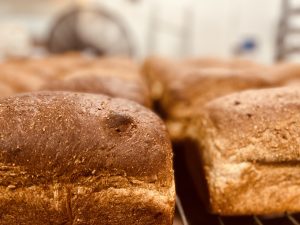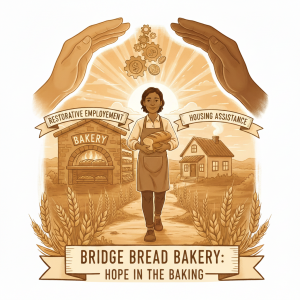Fresh is best
Ummmmmm! Fresh-baked bread! Is there anything better? And the aroma – to die for!

If you can bake your own bread or you can have a neighborhood bakery where you can buy bread within a couple of hours of the time it comes out of the oven, you should buy it, take it home, and eat it that day. This works especially well with crusty breads – crisp on the outside and soft and luscious inside.
Dry bread is not the same as stale bread
But if you can’t buy it within hours of baking or you can’t eat it all the same day you buy it, you will have to deal with ‘staling’ or ‘going stale’. This is a chemical and physical process that makes bread less tasty and makes it have a leathery texture.
https://en.wikipedia.org/wiki/Staling
But – Staling is not, as is commonly believed, simply a drying-out process due to evaporation. Bread will stale even in a moist environment and stales most rapidly at temperatures just above freezing.
Your refrigerator is the very worst place to keep bread if you want to avoid staling.
Here’s the technical description of the process:
the migration of moisture from the starch granules into the interstitial spaces, degelatinizing the starch. The starch amylose and amylopectin molecules realign themselves causing recrystalisation. This results in stale bread’s leathery, hard texture. Additionally, pleasant “fresh” flavor is lost to the air, and often unpleasant flavor is absorbed from it as well, especially in a confined space with other food such as when in a refrigerator.
Dealing with drying
Before we get into how to delay or stop staling, let’s spend a minute on drying. Dry bread is wholesome and tastes fine (if it’s not also stale). We’ve all eaten things made with dry bread – Italian bread crumbs, good French toast, some kinds of croutons, turkey dressing – and they can be delicious. But eating a slice of hard dry bread isn’t a treat. So if we want to keep our loaf for more than a couple of hours, we need to do one of two things:
- Keep it from drying out
- Or replace the lost moisture
Either one works pretty well on bread that hasn’t gone stale.
If you keep bread in a moisture-tight container like a freezer bag (not regular plastic wrap!), the moisture mostly stays in and the bread will not dry our much for several days. Bridge Bread uses bread bags that are moisture barriers and keep bread moist enough for at least four days and up to a week. During that time, the moisture is distributed pretty evenly throughout the loaf. Bridge Bread is a soft-crust bread, so this is okay. Crusty bread will get a bit leathery when kept in a moisture barrier bag.
If your bread does dry out, we have found a simple way to replace the moisture:
- Take the loaf out of the bag and drench the top of the loaf with running water in your sink
- Place the loaf in a cold oven and set the temperature to 375 degrees
- When the oven reaches 375, take the bread out using oven mitts and let it cool
The water will have steamed the interior of the bread and then evaporated from the crust, leaving the loaf pretty much like it was when fresh-baked.
For cinnamon rolls where the oven would ruin the frosting, just spray or sprinkle a little water on the rolls and microwave them. 15 seconds full power for 2, 30 seconds for 4.
Using additives to keep bread from going stale
Many commercial baked products use artificial additives for many purposes including delaying staleness avoiding mold, conditioning the dough and keeping the finished product soft. Bridge Bread does not use any additives in most of our products. We do use a special formulation of natural plant enzymes and some calcium proportionate in our hotel rolls, our sliced sandwich bread, and our awesome rolls. These enzymes break down in the baking process and are not actually present in the finished product.
Keeping Bridge Bread from staling before it’s sold
Bridge Bread is baked all week and mostly sold on weekends. So we need to forestall the staling process. It turns out to be pretty easy. We bake it, cool it, package it, and freeze it. We thaw it before it is shipped to customers. This is important – bread loves the freezer. Unlike vegetables and meat, bread has no cellular structure that is destroyed by water freezing into ice crystals. And this is important – freezing arrests the staling process. Plus – our moisture-barrier product packaging inhibits drying out. There’s a lot of buzz about freezing being ‘bad’ for food. Read the whole article – bread is the exception. It keeps in the freezer for up to three months. We only need a couple of days.
Keeping Bridge Bread from staling after it’s sold
Okay – you bought Bridge Bread on Sunday and it’s great. But you want to eat it on Friday. What to do? Again the answer is simple – refreeze it. Bread also refreezes well. Google ‘refreezing bread’ and you will see many article from academic to amateur that attest that one can safely refreeze bread. That’s not good enough. You want bread that better than safe. You want bread that’s safe and delicious. Bridge Bread will come through will flying colors again due to moisture-barrier packaging. Just make sure the packaging is securely closed.
If you leave it on the counter for more than a couple of days it’s much more likely to be dry than stale, especially if you open the package a few times. Just follow the instructions near the top of this article to replace the moisture.
Happy eating! Enjoy your Bridge Bread.

